
I’m sure you’d agree, using Google is easy!
Simply type a query in the search bar, and voila, you get a relevant set of results organized and ranked in order.
While searching Google is a straightforward task, if you’re looking for something a bit more specific, like a website accepting guest posts on a niche topic, you’ll know that regular keyword searches don’t hit the mark.
If you want to get the most out of Google, you can’t rely on basic queries. You need to leverage the power of advanced search operators.
Whether you’re a seasoned search professional or have only the most basic Googling skills…
This special Google search guide will walk you through every Google search operator out there so you can leverage these “cheat codes” and become a Google search master.
Not only will you obtain more refined search results, but you’ll also have the ability to focus your search queries to target your particular niche or objective.
In this guide, I cover the complete list of Google search operators as well as some fun Google tricks and easter eggs you can use to surprise your co-workers.
I’ve also put together 15 actionable tips and tactics to help you make your Google search tasks more productive and efficient.
- Basic Google Search Operators for SEO
- Advanced Google Search Operators for SEO
- Google Search Tips for Everyone (How to Google Better)!
- Unreliable Search Commands to Avoid
- Hidden Google Search Tricks You (Probably) Didn’t Know
- 15 Actionable Tips to Master Google Search Operators
Let’s jump into it.
Free Bonus: Access a search command generator that will instantly produce dozens of search operators you can copy and paste to Google to find roundups, resource pages, guest post opportunities and much more.
What are Google Search Operators?
Search operators are special characters and parameters you can include in your search query to return more refined and granular search results.

Search operators cover a whole range of functions, from allowing you to narrow results to an exact phrase or exclude specific terms from your results. Using a mixture of search operators lets you uncover detailed information hidden away in a typical query.
For instance, say you run a food blog and have recently written a guide on succeeding with the paleo diet.
After all that work, you want to get your post included in paleo-related resources.
A search of paleo diet resources returns a wide array of results, from how-to guides to resource pages.

5.84 million results are too many for you to comb through.
Here is where search operators come into play.
By using the right search commands, you can turn that 5.8 million results into a mere 6,990.

A much more manageable number!
What’s more, all of the links in the search results are purely resource pages, allowing you to pick and choose which sites you want to reach out to for that all-important backlink.
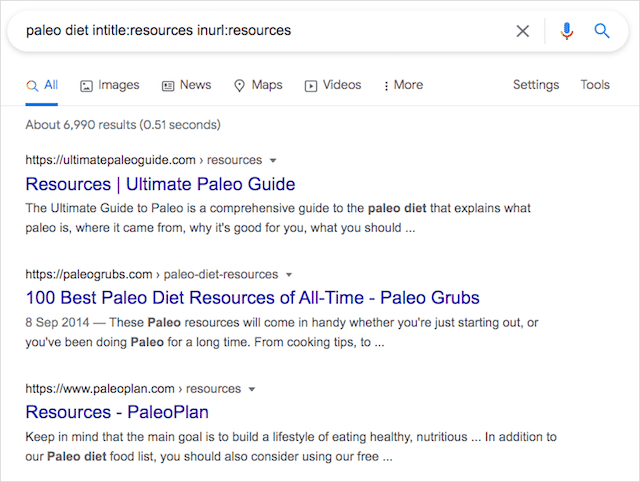
In other words:
By using the right combination of search operators, you narrow down those convoluted results into highly targeted and relevant findings.
But before we tackle how you can apply these search operators in your daily Google search tasks, let’s break down each command in more detail.
Basic Google Search Operators and Commands List
These basic search operators are useful commands that help transform your standard text searches into more practical and filtered search results.
Applying these attributes to your search terms will open up a whole new world of search possibilities.
“search term”
Using quotes (” “) refines search results by forcing an exact-match search. When wrapped around a single word, quotation marks exclude synonyms.

Example: “yoga”
OR
A search directive that tells Google to return results between two different search terms. This is useful for finding search results related to the two keywords. A pipe symbol (|) can also be used in place of OR.

Example: yoga OR pilates / yoga | pilates
AND
The AND operator will return results related to the search terms that have been typed into the search bar. Because Google’s algorithm can accurately determine the difference between multiple search terms and phrase search, the AND operator doesn’t make much difference.

Example: sunflower AND garden
-exclude
Adding a hyphen (or minus) in front of a search term will exclude any pages containing that keyword within its content. To exclude multiple search terms from appearing in your search result, additional hyphens are required.

Example: social media -facebook -instagram
site:
“Site:” is a search operator that allows you to restrict your search results to a given domain. The “site:” command is most effective when used in conjunction with other operators like “intitle:” to find specific pages that mention your search term or the minus (-) operator to exclude a specified domain.

Example: site:seosherpa.com
*
The asterisk symbol is considered a wildcard character in search because Google treats the asterisk as a “fill in the blank” or placeholder command. When the asterisk is used, Google will try to find the best match for the search term or phrase.

Example: obama * donation
( )
Brackets help to control search results by grouping multiple search terms or operators. Putting keywords in parentheses allows you to be more strategic with your search and refine your search results.

Example: (basketball AND football) athletes
#..#
Using (..) with two numbers on both sides will narrow your search results to the range of numbers included. The (..) operator helps find specific information within a date range or even prices, though the results can be inconsistent.

Example: wwdc keynote 2010..2014 / white shirt $25..$50
@
If you want to restrict your search to display only results posted from social media handles, use the “@” symbol in front of your keyword. The “@” symbol can be used to find a brand’s social media handles as well as businesses with a specific social media platform.

Example: @apple / facebook @apple
Advanced Google Search Operators and Commands: The Complete List
Now you are familiar with the basic building blocks of search operators.
Let’s now delve into the more advanced search operators that will help you return precise search results.
intitle:
The “intitle:” command will return the results of pages that contain the word or phrase used in the page title.
To find only pages with exact match phrases, use quotations (” “) around your search term.

Example: intitle:apple / intitle:”apple iphone 12″
allintitle:
Similar to “intitle”.
However, the “allintitle:” operator allows you to return results for page titles that contain all of the words in your search term.

This search operator is handy for SEO content and link building research and helps you quickly identify relevant content that could be a good target for outreach.
Example: allintitle:image seo guide
inurl:
If you want to find pages that contain a certain word (or words) in their URL use “inurl:”

Example: inurl:airpods
allinurl:
The “allinurl:” command is a specific search operator that returns results containing all searched keywords in the page’s URL. Using a search phrase that is too long may drastically reduce search volume or return no results at all.

Example: allinurl:seo content writing
intext:
The “intext:” Google search operator helps you find individual words or phrases within a page’s body. “Intext:” is rarely used as this search operator virtually functions the same as any Google search.

This command is most effective when used with another search operator like “site:” to find specific page content.
Example: intext:samsung smartphone
allintext:
“Allintext:” allows you to search a page’s body or document text for all of the specified keywords included in your search term.

Combining quotations (” “) to the search term will further narrow down the search to display exact match results.
Example: allintext:samsung galaxy 10 / allintext:”samsung galaxy 10″
filetype:
Using “filetype:” will restrict your search results to the specified file type such as PDF, DOCX, PPT, etc. The “filetype:” operator cannot be used on its own. Instead, it must be combined with another term to display results.
“Filetype:” can also be used to specify image types (PNG, JPG, GIF, etc.).

The “ext:” command can replace “filetype:” in the search term and return identical results.
Example: content marketing filetype:pdf
related:
When performing market or competitor research, “related:” will come in handy. The “related:” operator will help you find similar domains to the target URL you’ve included in the search bar.

This search command works best with larger domains.
Example: related:semrush.com
AROUND(X)
A proximity search operator, “AROUND(X)”, lets you find pages that contain any given search term with X words from each other. A search term like “digital marketing AROUND(3) SEO” will return results where “digital marketing” and “SEO” are separated by three words or less.

Example: digital marketing AROUND(3) SEO
cache:
If you want to know when a site or domain was last crawled by Google’s bots, use the “cache:” command. The “cache:” operator will return the most recent cache of a particular domain or URL. This will only work for sites that Google has indexed.

Note: The cached version of a domain will look different and displays a banner that specifies the date of the cached version.
Example: cache:clickjam.com
source:
The “source:” operator lets you view news content from a specified source in Google News. Using the “source:” command will display all of the keyword-related web pages from the source listed in the search.

Example: apple source:forbes
blogurl:
If you want to find the blog of a particular domain, use the “blogurl:” operator. The “blogurl:” command was initially used with the Google Blogs search, which got discontinued in 2011. While this command is now deprecated, it still returns relevant results from time to time, albeit inconsistently.

Example: blogurl:microsoft.com
loc:placename
To narrow your search to a specific location, use the “loc:” command. Location-specific searching is most effective when targeting a particular brand or business in one geographic area.

While not fully deprecated, the results tend to be unreliable.
Example: marketing agency loc:new york
location:
While similar to “loc:”, the “location:” operator returns news results from Google News for that given geographic area.

And just like the above, while “location:” is not officially deprecated, search results can be inconsistent.
Example: marketing agency location:new york
Google Search Tips and Tricks (How to Google Better)!
Want to use Google search more effectively for non-SEO tasks?
Here are my top Google search tips and tricks to maximize your search efficiency for day-to-day Googling:
$/€
The US and Euro symbols are handy when you need to search for products by their prices. Currently, $ and € are the only currency symbols that display prices. Other common currencies like GBP (£), JPY (¥) provide inconsistent results.

To further refine your search, you can combine a period with the currency symbol to display exact prices like “earphones $19.99”.
Example: iphone 12 $1000
in/to
When you want to convert between two equivalent units, use the “in” or “to” search command. The “in” and “to” operator can be used for numerous conversion applications such as currencies, temperatures, speed, etc.

Using the “in” command will display a Knowledge Card search result.
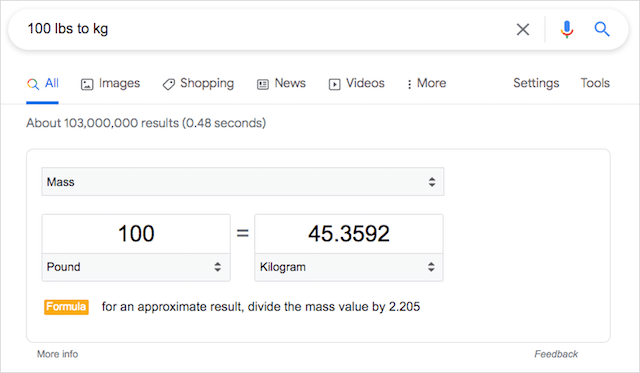
Example: 100 lbs to kg / 100 usd to eur
define:
Using the “define:” operator will enable you to access Google’s built-in dictionary, which Oxford Languages provide.

The Knowledge Card-style dictionary result also includes an audio player that phonetically sounds out the word and synonyms of your search term.

To access the dictionary with multiple keywords like content marketing, quotations must be used. Otherwise, the search will simply return a traditional Google search result.
Example: define:entrepreneur / define:”content marketing”
weather:
The “weather:” operator lets you check the weather and temperature of any given location.

The search result will be a weather-featured snippet. Beneath the weather featured snippet will be other popular and highly authoritative weather websites.

Example: weather:dubai
map:
To view map results directly from Google’s SERPs without clicking on the Maps tab in search results, use the “map:” command.

The “map:” operator will deliver a locational search as the top result.

Example: map:san francisco
movie:
Are you looking to learn more information about a certain movie?
The “movie:” command will return results about your specific movie such as trailers, film summaries, reviews, and so on. If the movie is still playing in cinemas, the results will also show movie showtimes.

Example: movie:the social network
stocks:
To see the stock information of a given ticker, use the “stocks:” command.

The search will return a Knowledge Card style result above the organic listings. “Stocks:” will work with either the company name or the stock’s ticker symbol.

Example: stocks:apple / stocks:aapl
near
A Google Maps search operator, the “near” command will list specific businesses matching your search term that are geographically situated near your IP address or location.

Even when “near” is used for a basic Google search, the first result tends to be a Google Maps widget and a local 3-pack.
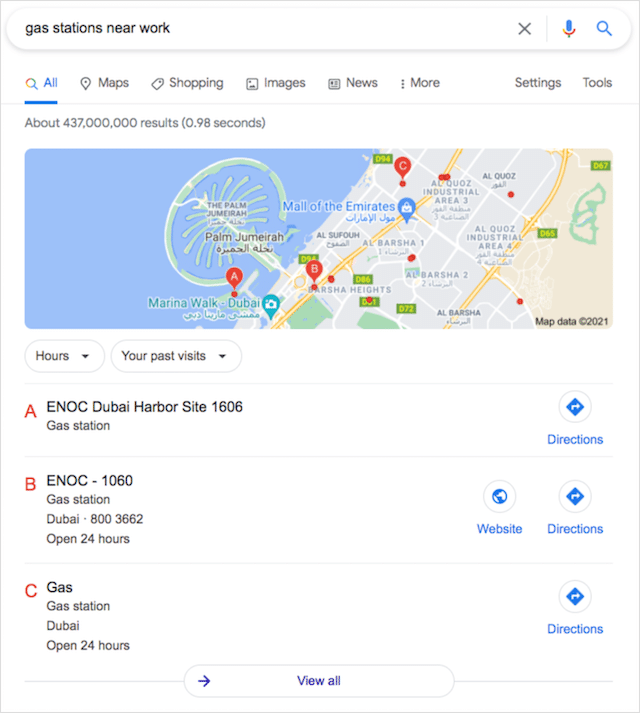
Example: gas stations near work
“business type”
Another Google Maps search operator, the “business type” command will return a selection of known businesses in a specific geographic area, typically near your location unless specified otherwise.

It’s important you consider your business category carefully for your Google My Business listing to ensure your business shows up for relevant results.
Example: cafe or restaurant
Unreliable or Deprecated Search Operators and Commands
With the basic and advanced search commands covered, let’s look at Google search operators that have become deprecated or are now defunct.
In other words, these are search operators you should stop using since they do not work now – or won’t in the future.
~
The tilde (~) symbol was previously used to search for similar keywords or phrases. By using “~”, Google search would deliver synonyms related to your search query. Google is now able to return synonyms by default, making this search operator obsolete.
Example: easter ~decorations
+
A prefix like a tilde symbol, using the “+” operator would force Google to return an exact-match search result for your given query. Google deprecated this search operator when it launched its social network Google+.
The “+” command was replaced by the quotation marks (” “) functionality in Google search.
Example: gates +microsoft
daterange:xxxxx-xxxxx
To search between specific dates, you were required to use the “daterange:” operator.
The only caveat was that this search command needed the use of Julian dates (yyddd date format). And since we now use the Gregorian calendar (mm/dd/yyyy), this operator is tricky to use.
What’s more, Google search returns inconsistent results with the “daterange:” functionality.
Example: wwdc daterange:11278-13278
inposttitle:
The “inposttitle:” operator was used in conjunction with Google blog search and allowed search users to find blog posts with the given search term in the blog title. When Google discontinued its blog search, this search command no longer works.
Example: inposttitle:weight loss exercises
allinpostauthor:
The “allinpostauthor:” let search users find specific authors on the Google Blog search vertical. The command was a quick and easy way to find content written by particular individuals.
This search operator became defunct when Google Blog search was discontinued in 2011.
Example: allinpostauthor:rand fishkin
inpostauthor:
Another Google blog search operator, the “postauthor:” command allowed you to search for blog content written by a specific author. Unlike “allinpostauthor:”, you needed to use quotation marks (” “) to narrow down your search to a particular author.
Example: inpostauthor:”james reynolds”
info:
The “info:” operator previously gave you more details about a site, ranging from its search snippet and Google cache link to similar sites that relate to your search query. Google deprecated that search command in 2017, and now “info:” only shows the search snippet.
The “id:” command is identical to the “info:” operator and returns the same results.
Example: info:seosherpa.com
link:
If you wanted to find pages linked to your target domain, you would use the “link:” command. While Google officially deprecated this search operator in 2017, it can occasionally return some results that prove beneficial.
With that said, since there are numerous backlink analysis tools out there, I’d recommend
Example: link:nytimes.com
phonebook:
If you wanted to find a number via Google search, you were once able to use the “phonebook:” command. Google decided to drop this search operator in 2010 after many businesses and individuals claimed this feature caused an “endless source of hassles.”
Example: phonebook:bill gates
#
Introduced to Google search as part of the search engine’s social network Google+, the hashtag/pound symbol “#” operator allowed search users to return hashtags from social media networks like Facebook and Twitter.
While deprecated by Google when Google+ ceased to function, the hashtag command still returns results, though inconsistently.
Example: #contentmarketing
Hidden Google Seach Tricks You’ll Want to Try Out
Now that you know how to maximize your Google search performance and get Google to deliver better results let me show you some fun Google tricks that you can use to surprise your friends and co-workers or accomplish more with your Googling.
timer
A nifty Google search feature, the “timer” functionality allows you to set a timer right down to the second. To access Google’s built-in timer, either enter “timer” into the search bar or type in the amount of time you want Google to count down to.
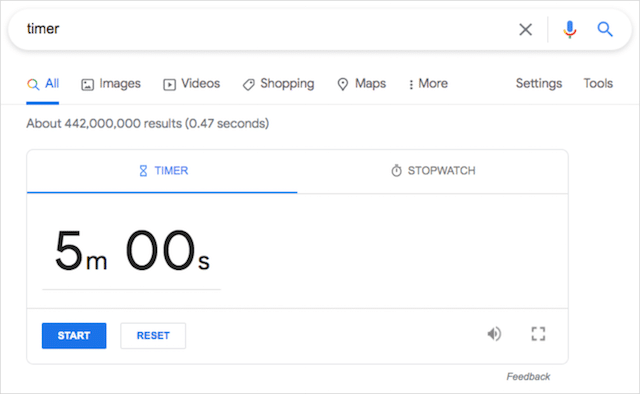
The latter will start a countdown immediately, while the former will allow you to add your custom time.
How to trigger this Google trick: 15 mins timer / timer
do a barrel roll/z or r twice
Want to see Google’s search page perform a 360-degree somersault? Simply type in “do a barrel roll” or “z or r twice” in the search bar and hit enter. The “do a barrel roll” easter egg was first introduced in November 2011 and has since been a staple of Google’s many hidden tricks.

The term “do a barrel roll” was popularized by the 1997 video game Star Fox 64 by a non-playable (NPC) character named Peppy Hare. The “z or r twice” command was how the player would execute the maneuver on the Nintendo 64 controller.
How to trigger this Google trick: do a barrel roll / z or r twice
askew
Have you ever wanted to see what Google search would look like tilted slightly to the right? Well, a software engineer at Google has heard your request and included just the easter egg for you. Typing “askew” into Google’s search bar will return results that are, well, slightly skewed.
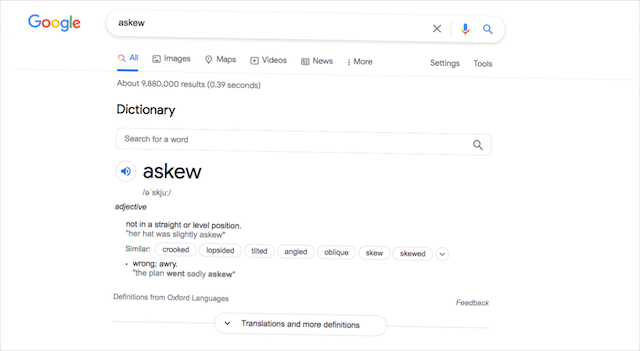
While similar searches like “slanted” and “tilt” used to work in the past, “askew” seems to be the only search term left that still results in Google search becoming lopsided.
How to trigger this Google trick: askew
Festivus
If you’re a Seinfeld fan, then you’ve probably heard of “Festivus,” a Christmas alternative celebrated on December 23. If you’d like to start celebrating this anti-consumerism holiday, CNN has a great article that helps get you in the Festivus mood.
With the holiday becoming a cult classic among Seinfeld fans, it’s evident that someone at Google must celebrate the Festivus holiday. To experience this Festivus miracle for yourself, type “festivus” into Google search, and you’ll see Google’s search page adorned with a Festivus pole.

How to trigger this Google trick: festivus
anagram
By definition, an anagram is a word or phrase that’s formed by rearranging the letters of another word or phrase. Some examples of anagrams include cinema from iceman, silent from listen, and dormitory from dirty room.
When you type “anagram” into Google search, the search engine willfully plays along and delivers an anagram of its own, which you can see below.

Typing in “define anagram” shows another playful anagram.

How to trigger this Google trick: anagram / define anagram
Zerg rush
Popularized by the video game StarCraft, “zerg rush” is a real-time strategy video game tactic where an overwhelming number of weak enemies attacks a player. Google decided to join the ranks of real-time strategy games by introducing the “zerg rush” easter egg.
Originally, one simply had to type “zerg rush” into Google’s search bar to access the hidden game. The search user had to destroy the army of Google Os that appeared in the SERP to win. The Os could be defeated by repeatedly clicking on them.
Google added the “zerg rush” easter egg in 2012 but has since removed it.

To access it today, head over to Google’s homepage and type “zerg rush”, and click the I’m Feeling Lucky button. You’ll be redirected to elgooG, a mirrored website of Google that maintains all of Google’s previous easter eggs.
How to trigger this Google trick: zerg rush
Google in 1998
When Google was founded in 1998, the search engine’s design is vastly different to what it looks like today. The original logo, for example, was far from polished and included an exclamation mark to match the Yahoo! logo.
If you’re curious about what Google looked like in its early days, before Google began rolling out its many SERP features, type “Google in 1998” in the search bar and hit enter. This easter egg was included in Google search to celebrate the search engine’s 15th birthday.

While you can’t perform any actual searches on this nostalgic version of Google, it’s fun to see how Google transformed over the years. Google even has a list of search engines around in 1998 at the bottom of the page.
How to trigger this Google trick: Google in 1998
Blink HTML
Do you have an appreciation for coding? Then you’ll love Google’s blinking easter egg. By typing “blink html” into Google search, you’ll trigger an easter egg that returns search results where the words “blink” and “html” turn into flashing text.

Other terms you can use to create blinking text in Google’s search results are <blink> and blink tag.
How to trigger this Google trick: blink html
Atari Breakout
As part of Atari Breakout’s 37th anniversary, Google decided to join in on the fun and release an easter egg for its search page. Search users could play this classic video arcade game directly on Google search by searching for “atari breakout” and clicking on the Images tab.

Unfortunately, the search term “atari breakout” was deprecated by Google, much like “zerg rush.” To play this Pong-style game today, you need to head to Google’s homepage, type in “atari breakout”, and click I’m Feeling Lucky.
How to trigger this Google trick: atari breakout
Secret Languages
What does Elmer Fudd, Klingons, Pirates, the Leet Language, and the Swedish Chef from the Muppets Show all have in common?
They’re the fictional languages Google offers its users.
To set one of these fictional languages as your search setting’s preferred language, navigate to the top right corner of Google and select Account > Data & personalization > Language. Click the + Add another language button and type in your desired fictional language.
There is another hidden fictional language, Pig Latin, though this cannot be accessed from your Account’s settings.

To try out the Pig Latin language interface, type in “www.google.com/?hl=xx-piglatin” into your browser’s address bar.
Pac-Man
Another classic arcade game, Pac-Man, was first released to the world in December 1980. Over 40 years later, Google continues to pay homage to this beloved video game classic with their Pac-Man Doodle.
To start playing a Google-inspired version of the classic game, simply type in “pac-man”, “play pac-man”, or “google pac-man” into the search bar and hit enter. An interactive featured snippet will appear, allowing you to play directly in the SERPs.

Use your arrow keys to control the eponymous character.
How to trigger this Google trick: pac-man
The Answer to Life
Any fan of Douglas Adams’ The Hitchhiker’s Guide to the Galaxy will know that “the answer to the ultimate question of life, the universe and everything” is 42. And while seemingly cryptic, Adams has gone on record to state that there has never been a deep, symbolic significance to the number 42.
Whether or not the number 42 has the special meaning ascribed to it, Google’s own “supercomputer” has decided to play along with Adams’ version of the true meaning of life. By typing in “the answer to life, the universe, and everything”, Google search will respond with 42.
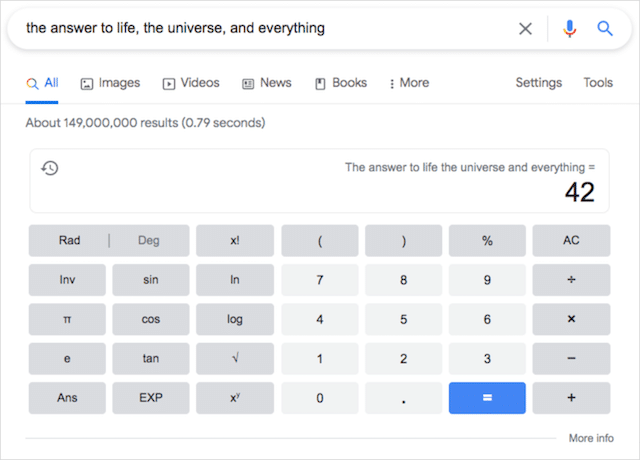
How to trigger this Google trick: the answer to life, the universe, and everything
Find Chuck Norris
Fans of internet memes will know all about the Chuck Norris facts, a list of satirical (and often exaggerated) factoids regarding the martial artist and actor Chuck Norris.
Some prominent examples of Chuck Norris facts include:
- Chuck Norris can divide by zero.
- Chuck Norris does not sleep. He waits.
- Chuck Norris counted to infinity… twice.
- Chuck Norris can build a snowman out of the rain.
- Chuck Norris can start a fire with an ice cube.
Google has decided to play along with this internet phenomenon by including Chuck Norris as one of their hidden easter eggs.
When you type “find chuck norris” or “where’s chuck norris” into Google’s homepage and click I’m Feeling Lucky, Google won’t return a search result or direct you to a website.

That’s because, as the absurd hyperbolic claims go, “you don’t find Chuck Norris; he finds you.”
How to trigger this Google trick: find chuck norris
Flip a Coin
Another nifty visual feature, searching “flip a coin”, results in a coin-flipping game appearing above Google’s organic listings. The coin will automatically flip once you click enter on the search bar.
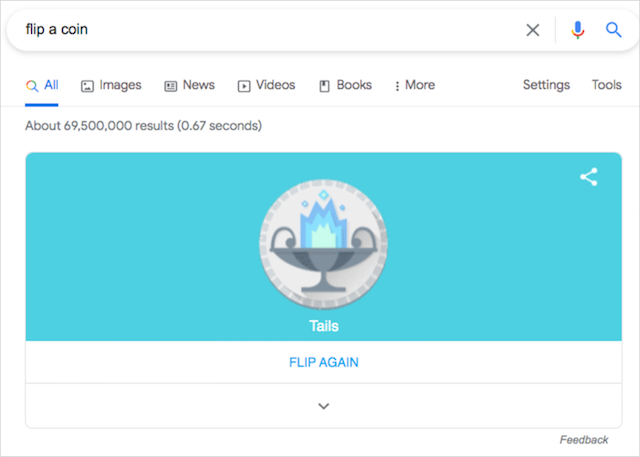
To flip the coin again, simply click the FLIP AGAIN text.
How to trigger this Google trick: flip a coin
Roll a Dice
If you prefer to roll dice over flipping a coin, then Google has the easter egg for you. All you have to do to unlock this Google trick is to search for “roll a dice” or “roll dice.” Google also offers several-sided dice to choose from, ranging from six-sided to twenty-sided die.

Users can also select their combination of dice, making the dice easter egg completely customizable.
How to trigger this Google trick: roll a dice
Tip Calculator
“42” is not the only graphical calculator easter egg that Google provides its users. Google can also help users quickly calculate the tip for their bill directly in the search results. The calculator can even divide the total amount of tip per person, making a convenient feature for a fun night out.
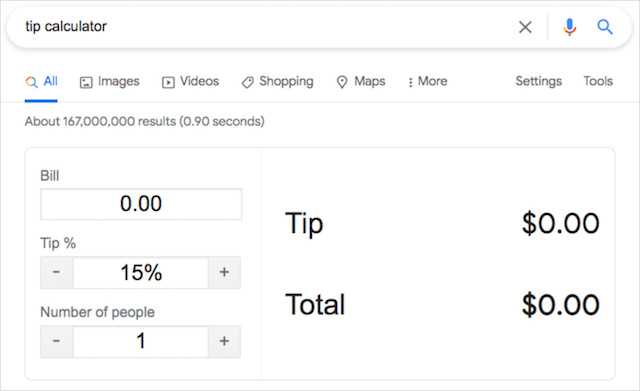
Other calculator easter eggs you can try out through Google are:
- the number of horns on a unicorn
- what is the loneliest number
- once in a blue moon
How to trigger this Google trick: tip calculator
Alex Trebek
When Alex Trebek, host of the game show Jeopardy, died in 2020, Google decided to honour the late game show host by including a special Jeopardy tribute to its search results page. When you search for Trebek’s name, Google corrects your search term by suggesting “who is alex trebek.”
This is a touching reference to the rules of Jeopardy, where contestants must answer the game’s clues with a “who is” or “what is” response.

How to trigger this Google trick: alex trebek
Super Mario Bros.
Another classic video game, Super Mario Bros., was first released in 1985 for the Famicom in Japan and the Nintendo Entertainment System (NES) in the United States. Super Mario Bros. has since gone on to become one of the most successful video game franchises.
Acknowledging Super Mario Bros’s storied legacy, Google has included a Mario-themed easter egg directly to its search results page. By typing “super mario brothers”, users will be shown a Knowledge Panel of Super Mario Bros., complete with a flashing “?” block.
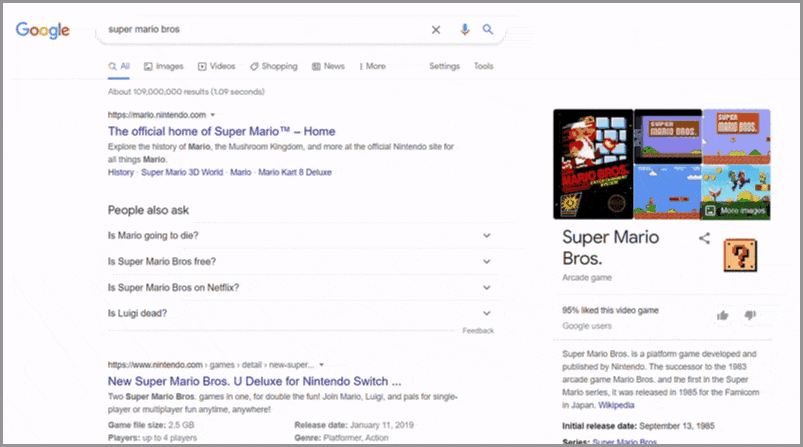
This glittering box is an in-game reference, where players can hit the block to earn coins. And just like in the video games, clicking on the coin box in Google’s search result will give you 200 points and produce the same coin sound effect from the Super Mario Bros. game.
And just like in the game, if you click the box enough times to collect 100 coins, you’ll be rewarded with the 1-UP sound.
Another classic video game, Sonic the Hedgehog, also has his own animated gif in his Knowledge Panel. Clicking on the waiting Sonic will make him spin. After a few clicks, you’ll see Sonic transform into Super Sonic.
How to trigger this Google trick: super mario brothers / sonic the hedgehog game
I’m Feeling Lucky
Google will often edit its logo to commemorate special events, holidays, or notable historical figures. These unique, temporary alterations to Google’s logo are known as Google Doodles and have been appearing on Google’s homepage since 1998.
If you miss any of these special logo edits or want to see every Google Doodle created, visit Google’s homepage and click on the I’m Feeling Lucky without typing anything into the search bar.
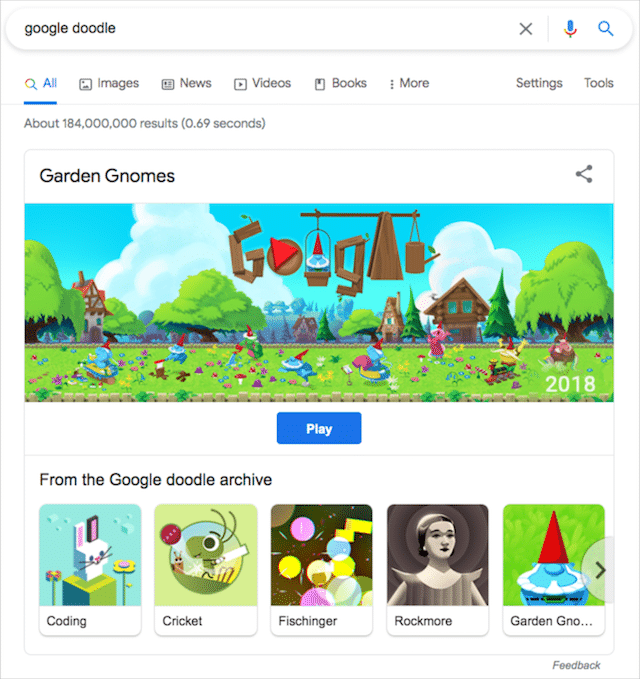
This will redirect you to the Google Doodle archive, where you can see all of the logo variations ever created and learn more about the history of Google Doodles. To view a random interactive Google Doodle directly in search results, type in “google doodle.”
How to trigger this Google trick: google doodle
15 Ways to Get the Most out of Your Google Search Operators
All of the search commands mentioned above will help transform your Google search skills from basic Googler to search powerhouse. But, to accomplish more with these search operators, you need to know how to mix and match them to your advantage.
Fortunately for you, I’ve compiled a list of 15 productivity boosters that will elevate your search capabilities beyond fun tricks and regular text searches towards Google mastery.
(1). Combine Numerous Operators Together
When it comes to search operators there is an infinite number of combinations.
The variety of commands you use is only dependent on your search requirement – and your imagination.
For example, if you’re looking for link building opportunities, namely sharing your content through link roundups, you can refine your search by using this set of search operators:
[keyword] “link roundup”
Using this combination of Google search modifiers, and the keyword “content marketing” I get 23,400 results:

But, I can focus the search even further by using the “intitle:” or “inurl:” search operators like so:
[keyword] intitle:”roundup” inurl:”round-up”
Now I’m down to 394 results:

Not bad!
Yet, I can still narrow my link roundup search even further by limiting the results to specific TLDs.
To do that, I combine the “site:” operator with the logical OR command:
[keyword] intitle:”roundup” inurl:”round-up” (site:com OR site:org)
And, now I’m down to just six results:

You get the point.
The more search operators you combine in your search string, the more refined your search will be.
(2). Finding and Removing Duplicate Content with Search Operators
Having the same content appear on multiple URLs within your site can result in duplicate content issues. When search engines like Google see duplicate content, they have a hard time differentiating between versions.
As a site owner, this can mean:
- Dilution of link metrics (e.g. link equity) resulting in ranking loss
- Lowering of search visibility, resulting in traffic loss
In some (though rare) cases, duplicate content can result in the site being de-indexed from the search engine.
To double-check your site for any duplicate content issues, you can use “site:” and “intitle:” search operators:
site:yourdomainname.com intitle:”suspected duplicate title goes here”
Using this example, you’ll be able to return results where pages have been duplicated with the exact (or similar) content throughout the domain.
Here’s one example I found when searching the Farfetch domain:
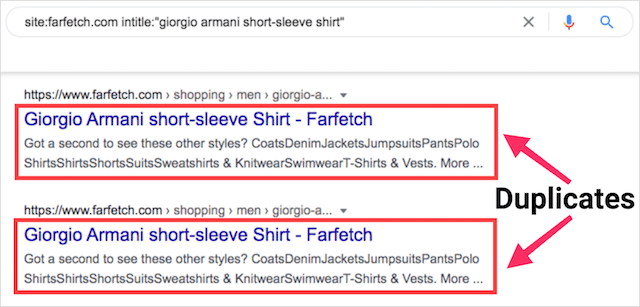
And, as you can see these pages are EXACTLY the same:

What’s more, replace “intitle:” with “intext:” and you can find entire content passages that have been repeated within a website. Here’s the specific Google search syntax:
site:yourdomainname.com intext:”suspected duplicate text goes here”
Digging deeper into the Farfetch duplicate content issue, I copied the product description that was used on both pages:

Pasted it in to my search string.

And found the text had been repeated across seven pages.
Duplicate content is a big issue among e-commerce sites.
Many sites have thousands, if not tens of thousands, of products.
So if you run an e-commerce store, I recommend you put these search operators to the test to help you locate duplicate content pages that may exist on your website.
SIDENOTE: For e-commerce sites with duplicate content issues, check out our URL slugs guide. It explains why you should never serve the same content across different URLs and what you can do to address any duplicate URL issues.
But duplicate content doesn’t just sit on your website alone. Some sites may copy your content in a bid to wipe away your rankings.
The following actionable tip will help you deal with plagiarism issues.
(3). Hunt Down Content Plagiarism with Search Operators
When there are two identical documents on the web, Google will pick the one with a higher PageRank and use it in the search results.

Which means:
If your domain is new and weak, you post content, and it gets stolen, you may be outranked by your own (plagiarized) article.
As you can imagine, if you’ve done the work to produce amazing SEO content, and you see that content outranked by copycat heavy-weights, it’s massively frustrating.
The good news is, you can easily hunt down plagiarism culprits with this search operator:
intitle:”suspected plagiarized content” -site:yourdomainname.com
Using the “intitle:” operator with quotation marks will ensure Google only returns results with exact-match titles. By including the “-site:” command in your search, you exclude any sites you don’t want to appear in the results.
Which, in this case, is your own domain as that is the originator of the content.
For example, if I perform this search using James’ post about SEO experiments, I uncover eight duplicate versions.

Thankfully, SEO Sherpa ranks top for this keyword, and each page links to our post as the source.
But if that wasn’t the case, I could reach out to these sites and ask them to remove the content or add a “rel=canonical” to our post.
SIDENOTE: You’ll notice I also excluded pinterest.com. This was because there were many Pinterest results for my query and I wanted to narrow the results further. There is no limit to the number of domains you can exclude.
Of course, someone else just copying your blog post’s page title is not necessarily indicative of outright plagiarism. To double-check that a block of text has been copied wholesale without your knowledge, use the “intext:” and quotation marks (” “) command. Here’s how it looks:
intext:”suspected plagiarized content” -site:yourdomainname.com
As you’ll see below, using the “intext:” operator with a passage from James’ post, returns many more results.

Both the quotation marks and “intext:” commands do perform similar functions.
However, the “intext:” operator is more nuanced than quotation marks and likely to yield larger results. Not all plagiarists will include your page title in their duplicate after all.
With that said, its well worth trying both.
(4). Use Search Operators to Assess Keyword Difficulty
The overwhelming majority of pages that appear on the first of Google contains the keyword they rank for in the title tag.

This means if you want to know whether a keyword is easy (or difficult) to rank for, knowing how many pages target that keyword in the title tag is particularly handy.
Enter the “allintitle:” search operator.
As the name suggest the “allintitle:” operator displays results where all specified keywords are included in the title tag. To use the command simply type allintitle: followed the keyword phrases you want to check for.
Here is an example:

And another example of the allintitle: operator:

As you can see, despite my example keywords being similar, the number of results returned for each is wildly different.
If I was considering writing a post, and wanted quick and easy rankings, I’d choose the second keyword.
With only 59 pages actively targeting that keyword (Vs 12,500 for “best seo practices”) my chances of ranking would be much higher.
(5). Find and Address Indexing Issues with Google Advanced Search Operators
Getting your website indexed is an essential first step to appearing on search engines.
If your pages are not indexed, they cannot rank. If your pages are indexed but not properly, expect lower search visibility and subpar rankings.
A basic search operator that will show you all the indexed pages for your domain is the site: command.
Here is what the site: operator returns when searching the seosherpa.com root domain:

It reveals Google has 112 pages indexed for the domain, which looks about right.
If there were a big mismatch between the actual number of pages on our website and the number of pages in Google’s index, this would cause investigation.
I can also use the same search operator to see if a specific page is indexed. To do that, use a complete URL with its respective slug, instead of only the domain:

This basic search operator is useful for checking if a page has gotten indexed after publishing.
Beyond the single-site search operator, there are other combinations of search operators that are useful for auditing indexation issues.
Find Non-Secure Pages
If you’ve recently migrated your site from HTTP to HTTPS, combining the”site:” and “inurl:” commands allow you to audit your website for rogue non-secure (HTTP) pages. Here’s how it looks:
site:yourdomainname.com -inurl:https
As the example demonstrates, be sure to include the exclusionary command “-” in front of the “inurl:” operator to omit any web pages on your site that have HTTPS in their URL.
When I searched for the National Football League (NFL) with the search operators listed above, Google returned 7,350 non-secure pages.

Despite the website being on secure https protocol:

That’s an issue.
Find Subdomains
Another search operator combo that can be used to help find indexation issues is:
site:*.yourdomainname.com -www
By including the wildcard (*) operator to the “site:” search term, you’re able to find all of the subdomains that exist within a domain. The exclusionary (-) command removes any domain results that contain the www in its URL.
This combination of search operators helps you identify rogue subdomains indexed on Google.
For instance, when I run this search operator on Yas Water World, I discover a staging website that requires a no-index tag adding to it to avoid duplicate content issues:
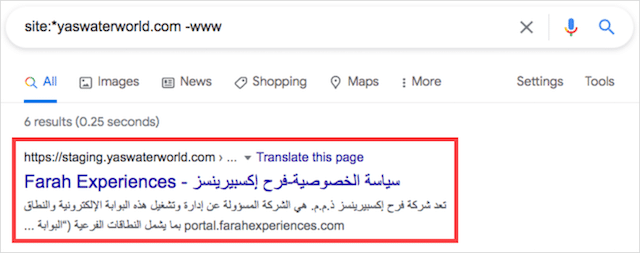
Give these indexation checkers a test on your own website. You may surprised by what you find.
(6). How to Keep Track of Forgotten Files on Your Site Using Search Operators
Knowing how to perform a file search is useful.
It can help find unused or old files that have been forgotten on your website over the years.
One of the most common file types you should check for on your website is PDF files.
site:yourdomainname.com filetype:pdf
But the “filetype:” command will let you search for all sorts of files hidden away in your domain.
Besides PDF, here is a list of all the file types that Google indexes and supports:
- Adobe Flash (.swf)
- Adobe Portable Document Format (.pdf)
- Adobe PostScript (.ps)
- Autodesk Design Web Format (.dwf)
- Google Earth (.kml, .kmz)
- GPS eXchange Format (.gpx)
- Hancom Hanword (.hwp)
- HTML (.htm, .html, other file extensions)
- Microsoft Excel (.xls, .xlsx)
- Microsoft PowerPoint (.ppt, .pptx)
- Microsoft Word (.doc, .docx)
- OpenOffice presentation (.odp)
- OpenOffice spreadsheet (.ods)
- OpenOffice text (.odt)
- Rich Text Format (.rtf)
- Scalable Vector Graphics (.svg)
- TeX/LaTeX (.tex)
- Text (.txt, .text, other file extensions)
- Basic source code (.bas)
- C/C++ source code (.c, .cc, .cpp, .cxx, .h, .hpp)
- C# source code (.cs)
- Java source code (.java)
- Perl source code (.pl)
- Python source code (.py)
- Wireless Markup Language (.wml, .wap)
- XML (.xml)
Remember, you can also replace the “filetype:” command with the “ext:” operator. Both are interchangeable and will perform the same task.
Using these search commands on Econsultancy’s domain, here’s what I found:

And when I clicked on the link, it simply returned a 404 error that I’m sure the webmaster at Econsultancy doesn’t want to appear in search results.

Multiple file types can also be used at the same time, for example:
site:yourdomainname.com (filetype:pdf OR filetype:docx)
This search query is looking for all files on a given domain with PDF and Microsoft Word extensions.
Super useful if you want to check if gated content like ebooks and guides have found their way in to Google’s index.
Now, let’s transition from searching for unwanted file types to improving your content marketing strategy.
(7). Find Missing Content Opportunities with the “Filetype:” Operator
The versatility of the “filetype:” search operator means it can also be used to support your content marketing strategy.
Depending on how large your site is or the age of your domain, you may have old yet relevant content that’s sitting hidden in the depths of your site in non-search optimized formats like PDF or Word Document.
As Andy Crestodina points out, PDF files are the “rust” of your site and only rank on search engines by accident.

“No serious search optimizer would recommend targeting a competitive phrase with a PDF file.”
Word Documents are just as bad, if not worse, than PDF files. Not only are Word Docs incapable of being optimized for search, but they’re also risky to open as they can contain viruses.
So if you have any of these files hidden on your website, doing a “site:” and “filetype:” search can help you pinpoint opportunities to transform them into rank-worthy HTML content.
(8). Use Search Operators and Find Relevant Link Building Opportunities
Link building gurus recommend using paid tools to bolster your link prospecting efforts, more often than not.
And while I’m not here to knock SEO tools (we use several to deliver our own SEO services), software is out of budget for many small businesses.
So how can you find relevant link building opportunities with limited resources?
By using search operators, of course.
One little-known search command that’s useful for your link building efforts, is this:
related:webaddress.com
The “related:” operator helps you uncover domains similar to the website stated in your operator.
Really handy if you’re trying to find relevant websites for your link-building campaigns.
For example:
A search for similar sites related to the Hubspot’s blog page returns 32 results.

That’s a really good number of opportunities you may not have found through other means.
What’s cool is, you can also use search operators to vet your opportunities for topical relevancy.
Ahrefs’ has outlined this formula which works really well:
- Pick a domain to target from your list of results.
- Perform a “site:” query and note the number of search results.
- Add a [niche] search to your “site:” query and note the number from that result.
- Divide your two numbers.
You want the quotient of your two numbers to be no less than 0.5 to be considered a relevant prospect. If the results are higher than 0.75, then the link prospect is incredibly relevant.
In short, this process measures the ratio of niche relevant content on the target website. The higher the quotient, the more relevant the website.
Let’s try this with the top result in the Hubspot example.
First, we perform a “site:” search:

Then we add our niche to the query:

Once we have two numbers from the results, we just divide the two numbers like so:
56,900 / 101,000 = ~0.56
As you can see, Marketo is a good prospect for Hubspot.
Of course, don’t just rely on search operators to find link prospects.
While the Ahrefs formula is a great way to eliminate irrelevant link prospects, I recommend you still manually check your potential prospect’s site before reaching out.
Link prospecting is not the only link-building capability of search operators. Let’s see how search operators can be used for guest posting opportunities.
(9). Leverage Search Operators to Find Guest Blogging Sites
Even after all these years, guest posting as a link-building practice is viewed with differing opinions. Some fully support guest posting, and some stay clear away from it.
Before I reveal how to find guest post opportunities with search operators, let’s see what Google actually says about guest posting.
Search Engine Journal has noted that Google has given out penalties or manual actions for sites that publish guest posts in several articles.
John Mueller has clarified Google’s stance on guest posting, saying that Google devalues links within guest posts.
So does this mean you should completely ignore guest posting?
Absolutely not.
As many in the SEO industry point out, guest posting still has value in amplifying brand awareness, especially if you target highly relevant and quality websites. And, Mueller specifically referenced paid guest posts rather than guest posting as a practice.
SEMrush’s Melissa Fach best sums up how you should go about writing guest posts in 2021 and beyond:

So how do you look for these highly relevant sites with search operators?
The most basic way of finding these sites is by using the “intitle:” command:
intitle:”write for us” [niche or keyword]
You can even include “inurl:” into your query to further qualify sites as a guest posting opportunity:
intitle:”write for us” inurl:”write-for-us” [niche or keyword]
This query will help you find sites looking for writers that relate to your keyword or content topic.
Other search terms you can try to find qualified guest posting sites are below:
- “Become a contributor”
- “Guest post opportunities”
- “Submit your content”
- “Contributing writer”
- “Suggest a post”
- “Contributor guidelines”
- “Guest post guidelines”
- “Accepting guest posts”
Be inventive with the phrases you use, as these are just a few examples of the many search terms available out there.
If your topic of expertise is email marketing, then your search results will look something similar:

Notice how I’ve added my niche in speech marks (” “) to narrow my results further.
Just like I’ve done, experiment with multiple search commands to find guest posting opportunities:
(intitle:”write for us” OR intitle:”become a contributor” OR inurl:”contributor-guidelines”) [niche or keyword]
That way you’ll uncover the greatest array of opportunities.
Once you find the right websites, carefully review their content and writing guidelines. You want to be sure that you’re offering to write content related to the blog you’re reaching out to.
It’s just a waste of your time and the editor’s time if you don’t do this research beforehand.
With guest posting covered, let’s see how search operators can be used to find sites that feature infographics.
(10). Use Search Operators to Find and Pitch Infographics
Infographics continue to be an effective visual medium for content marketing.
Infographics are the perfect creative outlet for conveying complex information in an impactful and visually pleasing way.
A well-designed infographic can make your content stand out, be easier to understand, and leave a significant impression on your readers’ minds.

But like in guest posting, you can’t simply blast your infographic outreach without rhyme or reason. It would be best to find websites that want to feature your infographics not to waste your outreach efforts.
And similar to guest posting, the best way to find sites to submit your infographic is to use the “intitle:” and “inurl:” search operators.
intitle:infographic inurl:infographic [niche/keyword]
To further ensure you find highly qualified sites for your infographic, consider using Google’s in-built date filter found under settings > advanced search. After all, a site that heavily published infographics two or three years ago may have pivoted and no longer accept infographics.

SIDENOTE: When pitching infographics to websites, the main thing to remember is the quality of the infographic and the message it’s trying to convey. You’ll want to create an infographic that’s visually persuasive and highlights your expertise.
Now let’s continue with link building operators to find resource page opportunities.
(11). Locate Resource Page Opportunities within Your Niche
Resource page link building is one of the most popular link building tactics out there, meaning that your business can benefit from building links with resource pages no matter your niche or industry.
But before we get into how you can find resource pages for link-building opportunities, let’s quickly define a resource page.
Resource pages are web pages that include a curated list of helpful industry resources. For example, a food blog that’s focused on the Keto diet may have a web page dedicated to Keto recipes, cooking tips, how-to guides, and so on.

Such a page would be considered a resource page.
Resource pages are a go-to link-building strategy (only second behind content publication or guest posting) for many businesses.

This is because resource pages link out to authoritative content on other sites and are typically aged and authoritative pages themselves.
Site owners want to keep the quality and quantity of their resource page links as high as possible. This means if you have a relevant resource (and it’s good) site owners won’t need much convincing to include it.
So how can you use search operators to find these resource pages and start building links?
You use the “intitle:” and the “inurl” operators.
intitle:”resources” inurl:”resources” [niche/keyword]
You can further narrow down your searches to avoid a lot of junk by using the search command “allintitle:”.
Once you’ve generated a list of resource pages that work with your niche, then you need to find their contact information and reach out and offer your content as a resource.
Speaking of outreach here’s an easy way to find contact details with search operators:
(12). How to Improve Outreach Prospecting with These Search Operators
If you have used any of these above strategies to find link-building opportunities, then it’s time to find the right people to contact so you can pitch your content.
Finding the correct contact details can be tricky but can be done with search operators.
site:targetdomain.com “name of author”

Typically, authors have their email address listed in their author bio or byline. But if their email address is not readily available, then another way to reach out to your prospective contact is through social media.
You can use the “site:” operator to find your contact’s social profiles.
author name targetsite.com (site:twitter.com OR site:facebook.com OR site:linkedin.com)

Once you have their social media handles, then you can contact them directly through their social accounts. At times, some authors may even mention their email address in their responses.
If these tactics still fail to produce the desired results for your outreach efforts, you can check our complete guide on finding anyone’s email address.
(13). Use This Search Operator to Steal Your Competitors’ Links
Without links, you cannot rank, period.
And, don’t just take my word for it. Google themselves admit that links are one of the top-ranking factors out there:
If your competitors are outranking you in search results, then chances are, their backlinks are better than yours.
Now, what if you could steal your competitors’ links and replace them with yours?
While it sounds too good to be true, this is possible with the “link:” operator.
link:https://competitordomain.com -site:competitordomain.com
NOTE: Google officially deprecated the “link:” command back in 2017. Still, as you can see below, it can yield results that may prove beneficial to your link-building efforts.

As you can see from the example, using the “link:” command will allow you to find any sites that refer to your competitors, while the exclusionary “site:” operator removes your competitor’s domain from the search results.
Since the “link:” operator is unreliable, I recommend you experiment with it to see what kind of backlinks you can loot from your competitors.
By the way, there’s another search operator you can use to further spy on your competitors.
(14). How to Use Search Operators to Find Competitor Mentions
Knowing where your competitors are mentioned on the web is a great way to inform your marketing strategy.
Even better if you can swipe their mentions list and use it for yourself.
To find a complete list of competitor mentions, use a combination of the “intext:” operator and an exclusionary “site:” command. Here’s how it looks:
intext:”competitor” -site:competitordomain.com
You can also include the OR operator to finding multiple competitors at the same time, like so:
(intext:”competitor 1″ OR intext:”competitor 2″) -site:competitorone.com -site:competitortwo.com
Competitor mentions also extend to content opportunities.
For instance, you can use search operators to find websites for whom your competitors have written content and approach those sites yourself.
To find these sites, use the quotation (” “) operator and the exclusionary or minus (-) command.
“Author name is” -competitordomain.com

Now that you’ve gone through all the trouble of finding guest posting opportunities and competitor mentions, let’s apply some search operator knowledge to your content writing efforts.
(15). How to Use Search Operators to Enhance Your Content with Relevant Statistics
Few things help your blog posts gain trust from their readers as research-backed statistics.
Compelling statistics from influential, high-authority websites makes readers believe you and can make your posts more persuasive.
In fact, a study was conducted on the impacts of statistics in writing, and researchers found that after a week of reading a story, statistical evidence was “more persuasive” and more memorable than anecdotal or story evidence.
So how can you find statistics that support your content from reliable sites?
You turn to Google, of course!
Using the “site:” operator, you can find trustworthy sites with research-backed statistics for your content.
For example, say you’re writing a blog post on the science of color and its impact on marketing and branding. To find actual research, rather than just a list of benefits or definitions, search for a scientific site with your keyword.

You can add the OR command to search for additional sources at the same time.

Just remember, when organizing your content, some statistics are best served as visuals. After all, we’re visual creatures and can process visual data much faster than text data. So when you really want to grab the attention of your reader, use visuals.
If you want to learn more strategies and techniques to improve your writing for SEO, you can check out this article on SEO content frameworks.
Over to you!
Mastering these search operators can turn your Googling skills into a powerful SEO and marketing tool. Knowing how to combine different search operators can help you uncover detailed information previously hidden away in Google’s SERPs.
Of course, I recommend you play around with all of these operators, from the most basic to the obscure ones, to understand their usefulness.
If there are any fantastic combinations you discover that help improves your Googling, which haven’t been mentioned in this post, leave a comment below.
I’ll happily include it in this database of search operators.
To help you out further, I’ve created a search operator generator you can use to quickly and easily find link-building opportunities for SEO.
Simply plug in your target keyword, and my generator will spit out dozens of search operators you can copy and paste in to Google.
Get access to the tool now (it’s free).











Leave a Reply